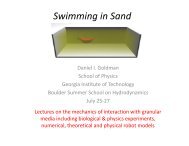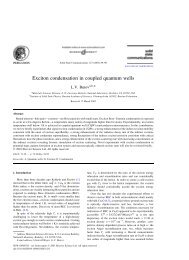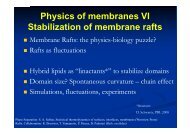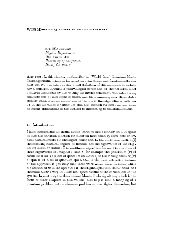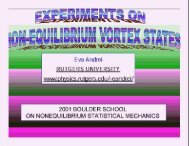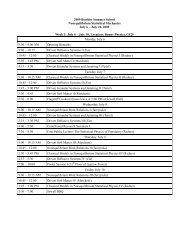Quantum gases in optical lattices - Boulder School for Condensed ...
Quantum gases in optical lattices - Boulder School for Condensed ...
Quantum gases in optical lattices - Boulder School for Condensed ...
You also want an ePaper? Increase the reach of your titles
YUMPU automatically turns print PDFs into web optimized ePapers that Google loves.
<strong>Quantum</strong> <strong>gases</strong> <strong>in</strong> <strong>optical</strong> <strong>lattices</strong>Feature: April 2004Arrays of ultracold atoms trapped by artificial crystals of light can be used <strong>in</strong> a wide variety ofexperiments <strong>in</strong> quantum physicsMounta<strong>in</strong>s of potential - <strong>optical</strong><strong>lattices</strong> offer unique control overmany-body quantum systems.Imag<strong>in</strong>e hav<strong>in</strong>g an artificial substance <strong>in</strong> which you cancontrol almost all aspects of the underly<strong>in</strong>g periodic structureand the <strong>in</strong>teractions between the atoms that make up thisdream material. Such a substance would allow us to explore awhole range of fundamental phenomena that are extremelydifficult - or impossible - to study <strong>in</strong> real materials. It maysound too good to be true, but over the last two yearsphysicists have come extremely close to achiev<strong>in</strong>g this goal.This breakthrough has been made possible by the convergenceof two related but previously dist<strong>in</strong>ct realms of research <strong>in</strong>atomic physics: quantum <strong>gases</strong> and <strong>optical</strong> <strong>lattices</strong>. The newfoundability to conf<strong>in</strong>e ultracold quantum <strong>gases</strong> <strong>in</strong> <strong>optical</strong><strong>lattices</strong> is already hav<strong>in</strong>g a major impact <strong>in</strong> fields as diverse ascondensed-matter physics and quantum <strong>in</strong><strong>for</strong>mationprocess<strong>in</strong>g.An <strong>optical</strong> lattice is essentially an artificial crystal of light - aperiodic <strong>in</strong>tensity pattern that is <strong>for</strong>med by the <strong>in</strong>terference oftwo or more laser beams. The simplest <strong>optical</strong> lattice consistsof the region of dark and bright stripes that is <strong>for</strong>med when two laser beams with the same wavelengthtravell<strong>in</strong>g <strong>in</strong> opposite directions meet each other and <strong>for</strong>m an <strong>in</strong>terference pattern. This <strong>optical</strong> lattice hasa period that is equal to half the laser wavelength. With more lasers - and enough care - it is possible to<strong>for</strong>m a perfectly periodic 3D spatial structure. It is more difficult, however, to use these <strong>in</strong>terferencepatterns to trap atoms.An <strong>optical</strong> lattice is able to trap an atom because the electric fields of the lasers <strong>in</strong>duce an electric dipolemoment <strong>in</strong> the atom. The <strong>in</strong>teraction between this dipole moment, which is oscillat<strong>in</strong>g, and the electricfield of the laser modifies the energy of the atom. If the laser frequency is less than a specific electronictransition frequency with<strong>in</strong> an atom, the atoms are pulled towards the regions of maximum laser <strong>in</strong>tensity.However, if the laser frequency is higher than the transition frequency, the atoms are pushed away fromthe maxima. Either way the atoms can be trapped <strong>in</strong> the bright or dark regions of the <strong>optical</strong> lattice, andthe strength of the <strong>optical</strong> potential conf<strong>in</strong><strong>in</strong>g the atoms can be <strong>in</strong>creased by turn<strong>in</strong>g up the laser <strong>in</strong>tensity(see Rolston <strong>in</strong> further read<strong>in</strong>g).Conf<strong>in</strong><strong>in</strong>g condensatesWhile some atomic physicists were experiment<strong>in</strong>g with <strong>optical</strong> <strong>lattices</strong>, others were explor<strong>in</strong>g whathappens when atoms <strong>in</strong> magnetic traps are cooled so close to absolute zero that quantum statisticsbecomes important. The study of quantum <strong>gases</strong> has been one of the hottest - and coolest - areas ofphysics research s<strong>in</strong>ce the first Bose-E<strong>in</strong>ste<strong>in</strong> condensates were created <strong>in</strong> 1995, and rema<strong>in</strong>s so to thisday (see "Fermionic first <strong>for</strong> condensates"). Over the past two years experimental groups <strong>in</strong> Europe andthe US have learned how to transfer a quantum gas from a magnetic trap to an <strong>optical</strong> lattice, and thishas led to a new generation of remarkable experiments.The behaviour of a gas at temperatures close to absolute zero depends on whether the atoms <strong>in</strong> the gasare fermions or bosons. Fermions obey the Pauli exclusion pr<strong>in</strong>ciple, which means that two of them cannotoccupy the same quantum state. No such restrictions apply to bosons, which means that large numbers ofthem can collapse <strong>in</strong>to the same quantum ground state. This process - known as Bose-E<strong>in</strong>ste<strong>in</strong>condensation - happens when bosonic atoms are cooled such that their de Broglie wavelength becomescomparable with the average distance between them.
In a Bose-E<strong>in</strong>ste<strong>in</strong> condensate the de Broglie waves of the <strong>in</strong>dividual atoms "beat" <strong>in</strong> the same way, suchthat all the particles can be described by a s<strong>in</strong>gle macroscopic wavefunction. Similar to laser radiation,condensates show a high degree of phase coherence. This means that if you know the phase of the matterwave at one po<strong>in</strong>t <strong>in</strong> space and time, you can predict what it will be at other po<strong>in</strong>ts and times. Phasecoherence is crucial <strong>for</strong> observ<strong>in</strong>g <strong>in</strong>terference patterns.To transfer a Bose condensate from a magnetic trap to an <strong>optical</strong> lattice, the condensate isillum<strong>in</strong>ated by the six laser beams needed to <strong>for</strong>m a 3D lattice and the laser <strong>in</strong>tensity is <strong>in</strong>creased to therequired value over a period of about 100 ms. This "load<strong>in</strong>g" process is computer controlled to ensureperfect reproducibility between different experiments, but it is difficult to prove that the condensate hasactually been transferred because the typical spac<strong>in</strong>g between sites <strong>in</strong> the lattice is too small (about 430nm) <strong>for</strong> the atoms to be imaged directly. However, a periodic pattern can show strik<strong>in</strong>g <strong>in</strong>terferenceeffects when illum<strong>in</strong>ated with coherent waves, and we can use this approach to check that the condensatehas <strong>in</strong>deed been transferred. We can also turn off the lattice potential and use the diffraction pattern tofollow how the atoms on the different lattice sites expand and overlap. S<strong>in</strong>ce the wavefunctions <strong>in</strong> thecondensate are phase coherent, an <strong>in</strong>terference pattern builds up as they overlap (figure 1a).Neutral atoms <strong>in</strong> <strong>optical</strong> <strong>lattices</strong>In 1998 Peter Zoller of the University of Innsbruck <strong>in</strong> Austria and co-workers published an <strong>in</strong>fluential paper<strong>in</strong> which they suggested that it should be possible to convert a weakly <strong>in</strong>teract<strong>in</strong>g Bose gas <strong>in</strong>to a Mott<strong>in</strong>sulator - a strongly <strong>in</strong>teract<strong>in</strong>g quantum state - by load<strong>in</strong>g the atoms <strong>in</strong>to an <strong>optical</strong> lattice (see Jakschet al. 1998 <strong>in</strong> further read<strong>in</strong>g). Three years later, Ted Hänsch, the author and co-workers at the MaxPlanck Institute <strong>for</strong> <strong>Quantum</strong> Optics (MPQ) <strong>in</strong> Garch<strong>in</strong>g observed such a transition <strong>for</strong> the first time (seeGre<strong>in</strong>er et al. <strong>in</strong> further read<strong>in</strong>g). This publication is currently one of the most cited papers <strong>in</strong> physicsaccord<strong>in</strong>g to the Science Watch newsletter.But how does this change from a superfluid to an <strong>in</strong>sulator actually come about? The potential depth <strong>in</strong>the <strong>optical</strong> lattice is almost always too large <strong>for</strong> the atoms to overcome the potential barrier between twoneighbour<strong>in</strong>g sites. On the other hand, quantum-mechanical tunnell<strong>in</strong>g allows the atoms to spreadthrough the lattice to some degree. In a Bose-E<strong>in</strong>ste<strong>in</strong> condensate, this tunnell<strong>in</strong>g process dom<strong>in</strong>ates thebehaviour of the atoms, which causes the system to <strong>for</strong>m a giant matter wave with perfect phasecoherence between the matter waves on different <strong>lattices</strong> sites.The number of atoms at each lattice site is a crucial factor <strong>in</strong> determ<strong>in</strong><strong>in</strong>g the properties of the system. Ifyou tried to measure the number of atoms on each lattice site <strong>for</strong> a Bose-E<strong>in</strong>ste<strong>in</strong> condensate, you wouldf<strong>in</strong>d that each site is filled with a random number of atoms accord<strong>in</strong>g to Poisson statistics. In other words,the phase of the coherent matter wave is well def<strong>in</strong>ed but the number of atoms fluctuates from site to site.This is not due to technical imperfections, but rather a fundamental uncerta<strong>in</strong>ty <strong>in</strong> macroscopic quantumfields: whenever the phase of the macroscopic field is well def<strong>in</strong>ed, the number of atoms fluctuates andvice versa.Although repulsive <strong>in</strong>teractions between the neutral atoms are usually weak, they can be made todom<strong>in</strong>ate the behaviour of the system by <strong>in</strong>creas<strong>in</strong>g the lattice depth and there<strong>for</strong>e reduc<strong>in</strong>g the amountof tunnell<strong>in</strong>g. Plac<strong>in</strong>g two atoms at the same lattice site then becomes extremely costly <strong>in</strong> terms of energy,and the many-body system there<strong>for</strong>e tries to avoid do<strong>in</strong>g it.The best way to achieve this situation is to <strong>for</strong>m a Mott <strong>in</strong>sulator <strong>in</strong> which each lattice site is occupied bya s<strong>in</strong>gle atom. The atoms are then isolated from each other, which results <strong>in</strong> the <strong>in</strong>teraction energy be<strong>in</strong>gzero. In a Mott <strong>in</strong>sulator the number of atoms on each lattice site is the same and does not fluctuate.However, this means that the phase coherence between atoms on neighbour<strong>in</strong>g lattice sites has beencompletely lost, which makes it impossible to observe a matter-wave <strong>in</strong>terference pattern (figure 1b).In our experiments at MPQ we were able to convert a superfluid Bose-E<strong>in</strong>ste<strong>in</strong> condensate to a Mott<strong>in</strong>sulator and back aga<strong>in</strong> several times by controll<strong>in</strong>g the depth of the <strong>optical</strong> lattice. One remarkableaspect about this phase transition is that it can occur even at a temperature of absolute zero. A classicalsystem cannot change its configuration at zero temperature because the thermal fluctuations that drivesuch a transition are absent. For a quantum system, however, <strong>in</strong>tr<strong>in</strong>sic vacuum fluctuations create a k<strong>in</strong>dof quantum-mechanical "jitter", which allows the system to change state even at absolute zero. Suchquantum phase transitions are currently of great <strong>in</strong>terest <strong>in</strong> condensed-matter physics and have also beenobserved <strong>in</strong> superconductors and quantum sp<strong>in</strong> cha<strong>in</strong>s (see "<strong>Quantum</strong> criticality <strong>in</strong> metals").
Figure 1(a) In the superfluid state of a Bose-E<strong>in</strong>ste<strong>in</strong> condensate the underly<strong>in</strong>g atomscan be described as a giant macroscopic matter wave. When such a condensate isreleased from the periodic potential, a multiple matter-wave <strong>in</strong>terference pattern is<strong>for</strong>med due to the phase coherence between the atomic wavefunctions on different <strong>lattices</strong>ites. In this case the phase of the macroscopic matter wave is well def<strong>in</strong>ed. However, thenumber of atoms at each lattice site fluctuates. (b) In the limit of a Mott <strong>in</strong>sulat<strong>in</strong>g stateeach lattice site is filled with a fixed number of atoms, but the phase of the matter-wavefield rema<strong>in</strong>s uncerta<strong>in</strong>. As a result, no matter-wave <strong>in</strong>terference pattern can be seenwhen the quantum <strong>gases</strong> are released from the lattice potential.The quantum <strong>gases</strong> <strong>in</strong> our experiments were cooled to almost absolute zero, but they still had some f<strong>in</strong>itetemperature, and this allows defects to <strong>for</strong>m <strong>in</strong> what would otherwise be a perfect Mott <strong>in</strong>sulator. This isrelevant to applications of <strong>optical</strong> <strong>lattices</strong> <strong>in</strong>, <strong>for</strong> example, quantum <strong>in</strong><strong>for</strong>mation: if the Mott <strong>in</strong>sulator is tobe used as a quantum register, then it is important that each site <strong>in</strong> the lattice conta<strong>in</strong>s the same numberof atoms. We are also try<strong>in</strong>g to f<strong>in</strong>d out which experimental parameters change most significantly at thetransition to a Mott <strong>in</strong>sulator, with the aim of ga<strong>in</strong><strong>in</strong>g a more profound understand<strong>in</strong>g of the phasetransition itself.Optical <strong>lattices</strong> have also been used to <strong>in</strong>vestigate various <strong>in</strong>trigu<strong>in</strong>g aspects of 1D quantum <strong>gases</strong>. Thedimensionality of a macroscopic quantum system can have a large impact on its physical behaviour, and itis there<strong>for</strong>e crucial to understand the role and effects of reduced dimensionality. Until recently, very fewclean experimental systems had been developed <strong>in</strong> which such dimensionality effects could be studied.Now, however, arrays of 1D quantum <strong>gases</strong> can be produced us<strong>in</strong>g 2D <strong>optical</strong>-lattice potentials. In these<strong>gases</strong> the atoms are conf<strong>in</strong>ed <strong>in</strong> tubes such that their radial motion is completely fixed and they can onlymove along the axial direction of the tube.
Figure 3 (a) Controlled <strong>in</strong>teractions between atoms on different lattice sites are possible with the help ofsp<strong>in</strong>-dependent lattice potentials. In such a potential, atoms <strong>in</strong> one <strong>in</strong>ternal state experience a potentialthat is different to that experienced by atoms <strong>in</strong> another <strong>in</strong>ternal state. These <strong>lattices</strong> can be movedrelative to each other such that two <strong>in</strong>itially separated atoms can be brought <strong>in</strong>to controlled contact. (b)This can be extended to <strong>for</strong>m a massive parallel quantum-gate array. Consider a str<strong>in</strong>g of atoms ondifferent lattice sites. First the atoms are placed <strong>in</strong> a coherent superposition of the two <strong>in</strong>ternal states(represented by red and blue). Sp<strong>in</strong>-dependent potentials are then used to "split" each atom such that itsimultaneously moves to the right and to the left, and is brought <strong>in</strong>to contact with the neighbour<strong>in</strong>gatoms. Here, both atoms <strong>in</strong>teract and a controlled phase shift, φ, is <strong>in</strong>troduced between them. Aftersuch a controlled collision the atoms are aga<strong>in</strong> moved back to their orig<strong>in</strong>al lattice sites.microseconds. By exploit<strong>in</strong>g this control over the beams, both <strong>in</strong>ternal states of the atom can experiencedifferent lattice potentials such that the atoms can be moved relative to one another.If some atoms <strong>in</strong> the lattice that are <strong>in</strong>itially <strong>in</strong>, say, a red <strong>in</strong>ternal state are converted <strong>in</strong>to atoms <strong>in</strong> a bluestate, these blue atoms can now be moved relative to the red atoms. Furthermore, they can be brought<strong>in</strong>to contact with other red atoms <strong>in</strong> the lattice by mov<strong>in</strong>g the blue lattice potentials relative to the redlattice potential. By controll<strong>in</strong>g such lattice shifts it is possible to move the atoms over a precisely def<strong>in</strong>edseparation and to br<strong>in</strong>g them <strong>in</strong>to contact with very distant neighbour<strong>in</strong>g atoms.This has allowed an exquisite degree of control over atoms <strong>in</strong> an <strong>optical</strong> lattice. For the first time we cancompletely control the <strong>in</strong>teraction between two atoms that would otherwise never have <strong>in</strong>teracted.Moreover, the periodic structure of the potential that the atoms experience has a powerful "parallelism"built <strong>in</strong>to it: with just a s<strong>in</strong>gle lattice-shift operation one can br<strong>in</strong>g each atom <strong>in</strong>to contact with itsneighbour<strong>in</strong>g atom, thereby <strong>for</strong>m<strong>in</strong>g a powerful quantum-gate array. Such quantum-gate arrays could behighly useful <strong>for</strong> generat<strong>in</strong>g entangled many-body states, which are a fundamental resource <strong>for</strong> quantum<strong>in</strong><strong>for</strong>mation process<strong>in</strong>g (figure 4).
Figure 4: Interference patterns are a crucialsignature that a quantum gas has been conf<strong>in</strong>ed <strong>in</strong>an <strong>optical</strong> lattice. After apply<strong>in</strong>g a quantum-gatearray <strong>for</strong> different lengths of time the many-bodystate of the atoms (left) evolves <strong>in</strong>to an entangledstate, <strong>for</strong> which no <strong>in</strong>terference pattern can beobserved, and back to a disentangled state (right),<strong>for</strong> which an <strong>in</strong>terference pattern can aga<strong>in</strong> be seen.This periodic evolution of the many-body systemdemonstrates the full coherence of the controlledcollisions that were <strong>in</strong>troduced between the atoms.The images represent the density distribution of theexpand<strong>in</strong>g atoms after they have been released fromthe lattice potential. A high peak denotes a highcolumn density, which has also been encoded <strong>in</strong>to acorrespond<strong>in</strong>g colour.Figure 5: By impos<strong>in</strong>g a "superlattice" on top ofthe normal <strong>optical</strong> lattice it is possible to per<strong>for</strong>mpatterned load<strong>in</strong>g of the lattice. In (a) only everythird lattice site conta<strong>in</strong>s atoms, whereas <strong>in</strong> (b)every site is occupied. This can be seen bycompar<strong>in</strong>g the matter-wave <strong>in</strong>terference patternsof the two configurations: the large separationbetween atoms <strong>in</strong> (a) results <strong>in</strong> the <strong>in</strong>terferencepattern hav<strong>in</strong>g a smaller period. If, on the otherhand, the spac<strong>in</strong>g between the matter waves issmaller, as it is <strong>in</strong> (b), the period of the<strong>in</strong>terference pattern <strong>in</strong>creases. This is analogousto coherent light diffract<strong>in</strong>g from a grat<strong>in</strong>g with alarger and smaller grat<strong>in</strong>g period. Credit: WPhillips and T Porto/NIST Gaithersburg.A major challenge <strong>in</strong> us<strong>in</strong>g <strong>optical</strong> <strong>lattices</strong> <strong>for</strong> quantum <strong>in</strong><strong>for</strong>mation process<strong>in</strong>g is to address s<strong>in</strong>gle atomson different lattice sites. This would allow us to read and write <strong>in</strong><strong>for</strong>mation <strong>in</strong>to selected atoms <strong>in</strong> the sameway that an <strong>in</strong>dividual bit is used <strong>in</strong> a classical computer register. Recently Dieter Meschede and coworkersat the University of Bonn <strong>in</strong> Germany have shown that magnetic fields can be used to selects<strong>in</strong>gle atoms that are separated by a few lattice sites, although it rema<strong>in</strong>s to be seen whether such anadvanced level of control can be extended to the quantum register of a Mott <strong>in</strong>sulator.Phillips and co-workers at NIST are explor<strong>in</strong>g other ways to address s<strong>in</strong>gle atoms. In one experiment theyhave loaded atoms <strong>in</strong>to every third site <strong>in</strong> the lattice by superimpos<strong>in</strong>g a so-called superlattice on top of aregular lattice pattern (see figure 5 and Peil et al. <strong>in</strong> further read<strong>in</strong>g). The <strong>in</strong>creased distance between theatoms should make it possible to use a focused laser to manipulate s<strong>in</strong>gle atoms. The same team has alsochanged the spac<strong>in</strong>g of the lattice by controll<strong>in</strong>g the angle under which the laser beams <strong>in</strong>terfere. In suchan "accordion lattice" one could quickly change from a small lattice spac<strong>in</strong>g to a large lattice spac<strong>in</strong>g toaddress the atoms <strong>in</strong> the lattice.
Ultracold fermions <strong>in</strong> <strong>optical</strong> <strong>lattices</strong>Spectacular advances <strong>in</strong> the field of degenerate Fermi <strong>gases</strong> now offer the possibility of load<strong>in</strong>g ultracoldfermionic <strong>gases</strong> <strong>in</strong>to <strong>optical</strong> <strong>lattices</strong>. Last year, <strong>for</strong> <strong>in</strong>stance, Massimo Inguscio and co-workers at theUniversity of Florence <strong>in</strong> Italy studied the peculiar transport properties of bosons and fermions <strong>in</strong> periodicpotentials. Here the cold fermionic quantum gas was slightly displaced from the <strong>optical</strong> trapp<strong>in</strong>g potential.The Florence team showed that the non-<strong>in</strong>teract<strong>in</strong>g fermions cannot support a DC current, which is what isexpected given their special collisional properties and leads to a p<strong>in</strong>n<strong>in</strong>g of the atoms to their localdisplaced position. However, by add<strong>in</strong>g a slight admixture of bosonic particles, the fermionic atom cloudrelaxed towards the centre of the trap due to collisions between the bosons and the fermions.Meanwhile, Misha Lukh<strong>in</strong> and colleagues at Harvard University have po<strong>in</strong>ted out that degenerate Fermi<strong>gases</strong> <strong>in</strong> higher-dimensional <strong>optical</strong> <strong>lattices</strong> could be used to <strong>in</strong>vestigate high-temperature superfluidity.This could shed light on whether or not high-temperature superconductivity is conta<strong>in</strong>ed with<strong>in</strong> the"Hubbard model" that describes how <strong>in</strong>teract<strong>in</strong>g fermions behave <strong>in</strong> period potentials.Unique systemsUltracold atoms <strong>in</strong> <strong>optical</strong> <strong>lattices</strong> have the potential to impact on a broad range of physics. Not only canthey be used as efficient quantum simulators <strong>for</strong> problems <strong>in</strong> condensed-matter physics, but it seems thatthe unique level of control that is available <strong>in</strong> these systems will also ensure their place <strong>in</strong> atomic physicsand quantum optics. The huge quantum register provided by a Mott <strong>in</strong>sulator, <strong>for</strong> example, offers uniquepossibilities <strong>for</strong> quantum <strong>in</strong><strong>for</strong>mation process<strong>in</strong>g, although we still need to develop ways <strong>in</strong> which toaddress s<strong>in</strong>gle atoms.Another major challenge rema<strong>in</strong>s to eng<strong>in</strong>eer new many-body quantum phases, and to comb<strong>in</strong>e <strong>optical</strong><strong>lattices</strong> with the recently observed condensation of molecules made from fermionic atom pairs. Thisspecial comb<strong>in</strong>ation could allow us to explore some of the most fundamental many-body systems <strong>in</strong>condensed-matter physics. Our understand<strong>in</strong>g of and ability to control quantum systems have never beenso good.AuthorImmanuel Bloch is at the Institut für Physik, Johannes Gutenberg-Universität, Ma<strong>in</strong>z, Germany, e-mailbloch@uni-ma<strong>in</strong>z.deFurther read<strong>in</strong>gFurther read<strong>in</strong>g M Gre<strong>in</strong>er et al. Nature 415 39D Jaksch et al. 1998 Cold bosonic atoms <strong>in</strong> <strong>optical</strong> <strong>lattices</strong> Phys. Rev. Lett. 81 3108D Jaksch et al. 1999 Entanglement of atoms via cold controlled collisions Phys. Rev. Lett. 82 1975B Laburthe Tolra et al. 2003 Observation of reduced three-body recomb<strong>in</strong>ation <strong>in</strong> a fermionized 1D Bosegas arXiv.org/abs/cond-mat/0312003O Mandel et al. 2003 Controlled collisions <strong>for</strong> multiparticle entanglement of <strong>optical</strong>ly trapped atoms Nature425 937H Moritz et al. 2003 Excit<strong>in</strong>g collective oscillations <strong>in</strong> a trapped 1D gas Phys. Rev. Lett. 91 250402S Peil et al. 2003 Patterned load<strong>in</strong>g of a Bose-E<strong>in</strong>ste<strong>in</strong> condensate <strong>in</strong>to an <strong>optical</strong> lattice Phys. Rev. A 67051603S Rolston 1998 Optical <strong>lattices</strong> Physics World October pp27-32 (full article <strong>in</strong> pr<strong>in</strong>t edition only)







